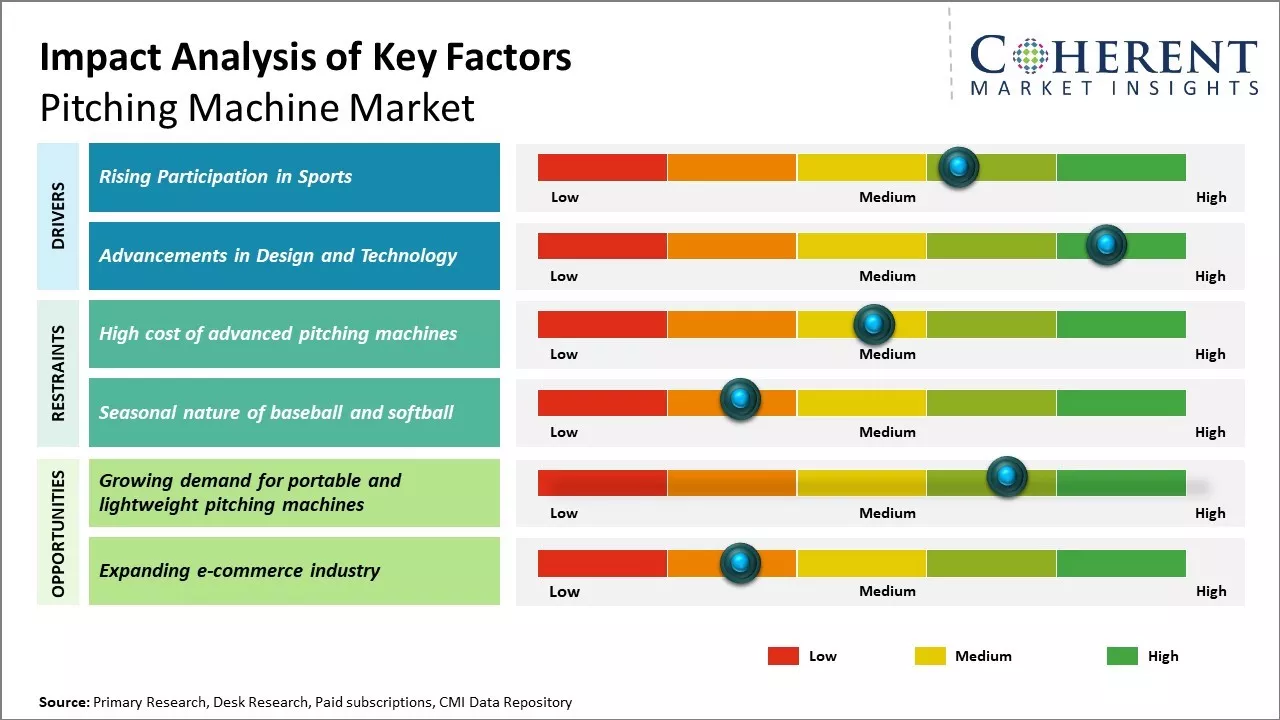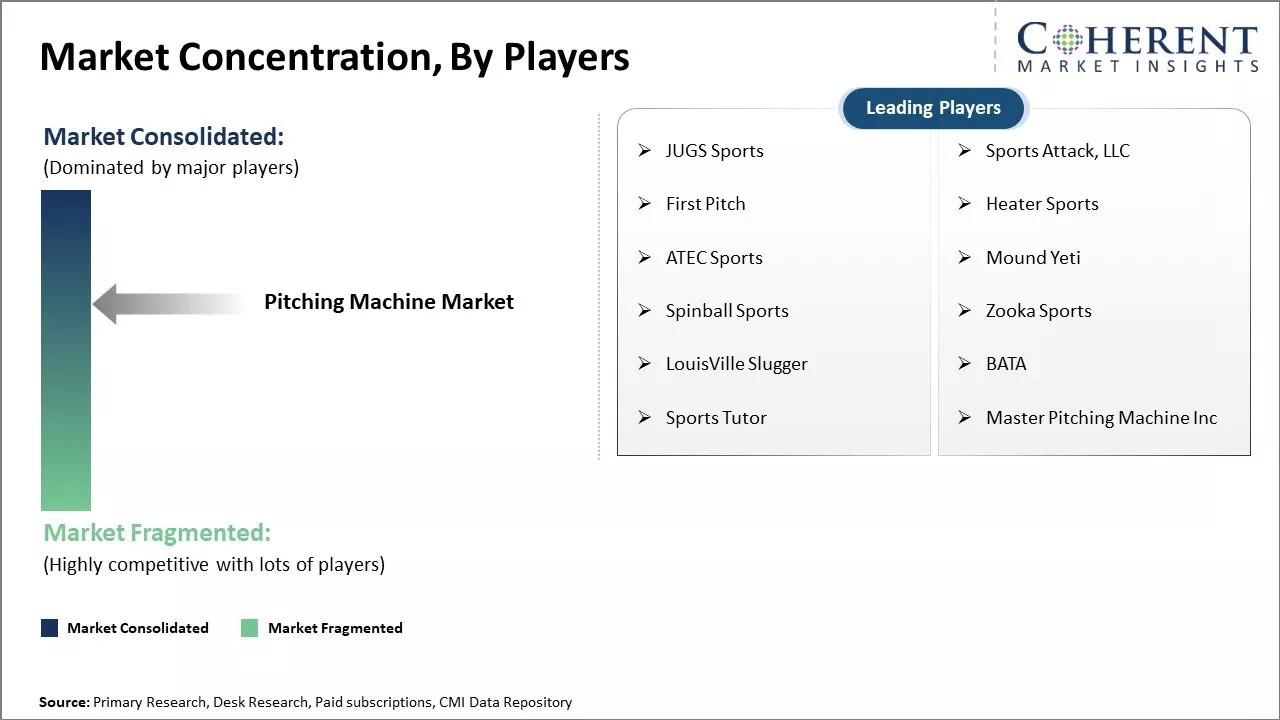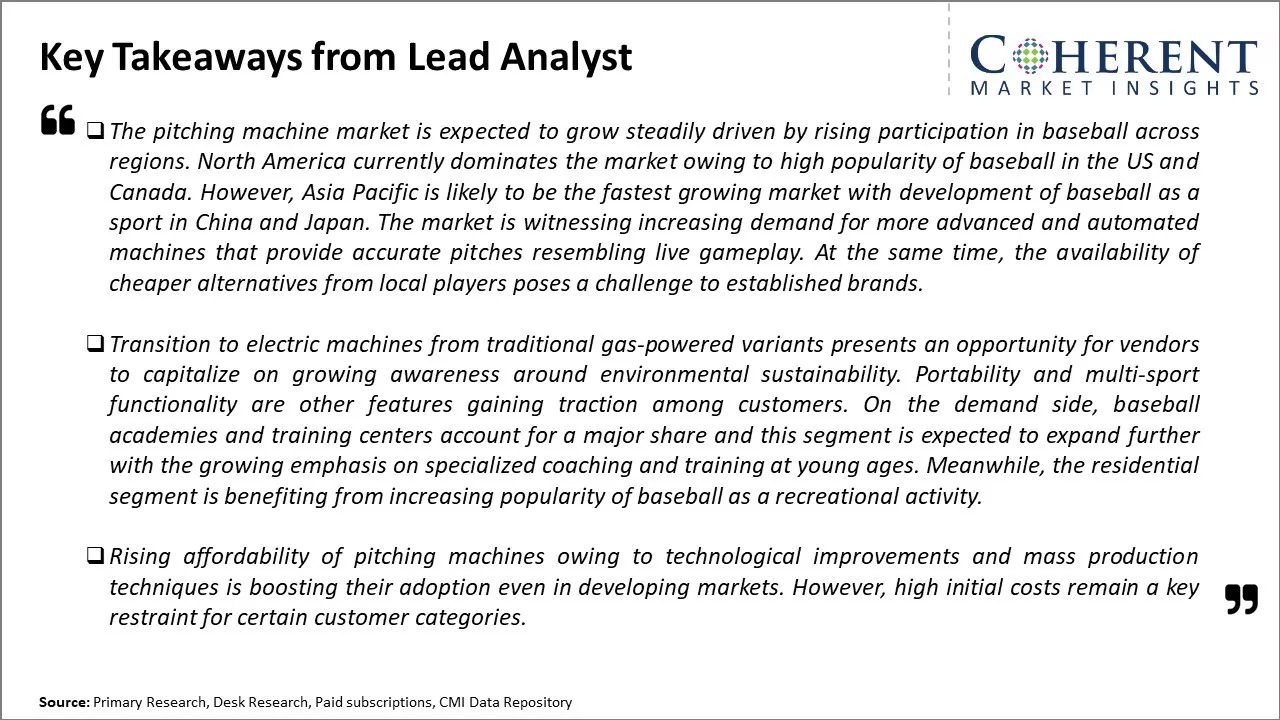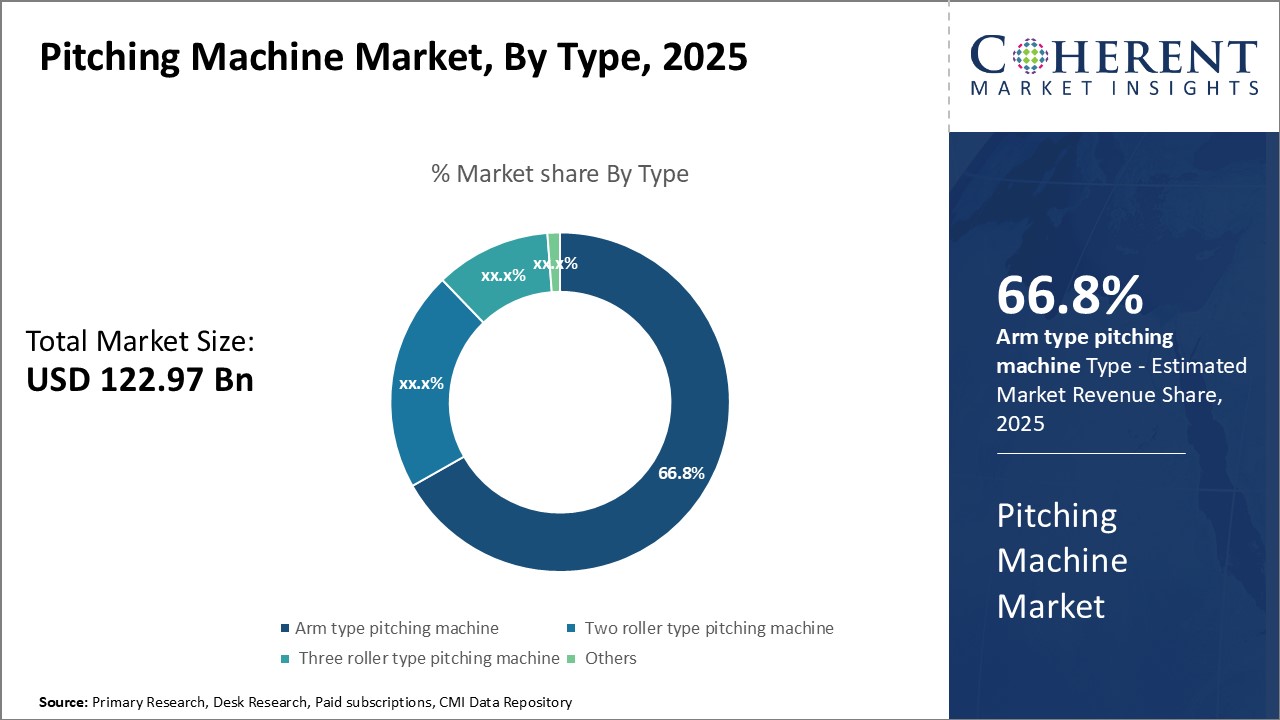Pitching Machine Market Size and Trends
The pitching machine market is estimated to be valued at USD 122.97 Bn in 2025 and is expected to reach USD 179.00 Bn by 2032, growing at a compound annual growth rate (CAGR) of 5.5% from 2025 to 2032.

Discover market dynamics shaping the industry: Download Free Sample
The pitching machine market is expected to witness positive growth over the forecast period. Key factors such as rising participation in baseball across various countries and growing popularity of the sport among youngsters is driving the demand for pitching machines. Furthermore, the incorporation of advanced technologies by manufacturers to develop innovative products with improved performance is also expected to support the market growth. However, high initial costs of pitching machines may hinder widespread adoption, specifically in price-sensitive markets. Nonetheless, the introduction of affordable options by local players is expected to help address this issue to a certain extent.
Rising Participation in Sports
Pitching machines are being increasingly adopted by amateur and youth baseball teams to help players improve their batting and fielding skills. More and more schools and local sports clubs are investing in automated pitching machines to add an element of realism to practice sessions. This allows players to face balls thrown at varying speeds and trajectories, better preparing them for real games. The convenience and consistency provided by machines over live pitchers has made them especially popular for daily use. With growing health awareness, communities are also developing many public sports parks and fields to encourage outdoor activities among citizens. This is creating greater opportunities for casual players to organize pickup games utilizing pitching machines. The low cost and easy setup of basic machines has removed earlier barriers for access. Their usage is no longer limited to competitive teams and academies.
Youth participation in baseball remains strong in North America, supported by initiatives to engage children in sports at a young age. However, coaches and parents now recognize the need for continuous practice to achieve higher skills. Pitching machines satisfy this need by enabling repetitive drills without excessive reliance on the coach's time. They provide a balanced combination of learning and enjoyment critical to retaining interest in sports over the long term. Studies also show machine-based training leads to improvements equivalent to working with live pitchers. This promotes the adoption of automated aids as a core part of modern little league training regimens. With growing emphasis on developing well-rounded individuals, schools are allocating greater resources to robust sports programs. This expanding youth player base will sustain the demand for pitching machines.
Market Concentration and Competitive Landscape

Get actionable strategies to beat competition: Download Free Sample
Advancements in Design and TechnologyPitching machines have evolved significantly from their early generations that offered only basic ball throwing functions. Manufacturers are continuously enhancing designs to deliver performance closer to real-life conditions. Advanced sensors and microprocessors now allow machines to emulate a pitcher's repertoire of speeds, locations, and movements. Some high-end models can automatically adjust their ball trajectories based on the batter. These sophisticated features are generating a strong appeal beyond amateur levels. Coaches at competitive high-schools and colleges are incorporating the latest precision machines for scouting, as they enable consistent evaluation of players against different pitching scenarios. Technology is also making the machines safer and more durable. Stronger composite materials and automatic safing mechanisms minimize risks while delivering greater reliability crucial for higher training volumes.
The shifting design emphasis towards playability is expanding the potential market by attracting casual adult leagues and slow-pitch softball.

To learn more about this report, Download Free Sample
Market Challenges: High cost of advanced pitching machinesOne of the key challenges faced by the pitching machine market is the high costs associated with manufacturing advanced pitching machines. As technology advances, consumers expect machines that can throw various pitches at varying speeds and trajectories, similar to professional pitchers. However, developing such sophisticated mechanisms requires extensive research and testing that adds significantly to production expenses. Keeping costs down while continuing to innovate is a difficult balancing act for manufacturers.
Market Opportunities: Growing demand for portable and lightweight pitching machines
With the rising popularity of baseball and softball among both amateur and professional players, the demand for quality training equipment is growing. Portable and easy-to-use machines allow players to practice anywhere, individually or in groups. Technologies like smartphone integration and data analytics also offer potential for enhanced training and engagement. As machines become more affordable and versatile, a broader consumer base can be tapped into, expanding the market considerably.

Discover high revenue pocket segments and roadmap to it: Download Free Sample
Insights, By Type- Reliability and DurabilityIn terms of type, two roller type pitching machine contributes the highest share of the market owing 66.8% in 2025 to its reliability and durability advantages over other types. The two roller design offers consistent ball speed and spin across a long period of usage with minimum hassle of repairs or replacements required. Unlike arm type machines that are prone to mechanical faults over time, or three roller machines that require frequent roller realignments, two roller pitching machines maintain their performance for years of regular practice sessions and games. This translates to lower total cost of ownership for clubs, schools and serious individual players who rely on pitching machines for regular training. The simple but rugged construction of two roller machines allows them to withstand weathering from outdoor use better than complex arm or three roller designs. Their self-contained design with fewer moving parts also makes them more durable options for portable use at different venues.
Insights, By Application- Coaching Versatility
In terms of application, clubs contributes the highest share of the market owing 38.2% in 2025 as pitching machines enable versatile coaching methods for players of all ages and skill levels. Coaches can customize the speed, location, and spin of each pitched ball using machines to perfectly match drills for different aspects of a player’s techniques – from batting stances to swing mechanics. Players get consistent practices that professional scouting software and high speed cameras allow coaches to deeply analyze. Machines also let coaches work with multiple hitters simultaneously on different stations, increasing coaching efficiency. Their objective accuracy and repeatability helps identify technical flaws more easily compared to human pitchers. Portable machines further assist age-group and travelling clubs to conduct effective practices anywhere and anytime.
Insights, By Sports- Developmental Advantages
In terms of sports, baseball contributes the highest share of the market owing 61.8% in 2025 as pitching machines provide clear developmental advantages over other options for the sport. Unlike in softball where live pitchers are more common even at junior levels, baseball widely relies on machines for training batters from early ages. This is because baseball pitches have higher speeds and more complex motions that young players need to safely develop their swing mechanics against without risks from other human pitchers. Machines also allow players to face different speed and location pitches on demand, better preparing their batting skills for competitive matchups. Their consistent delivery further helps players, coaches, and parents accurately measure progress in hitting abilities over time through repetitive, quantifiable practices.
Regional Insights

Need a Different Region or Segment? Download Free Sample
North America has established itself as the dominant region in the pitching machine market. The presence of major manufacturers such as JUGS Sports, Sports Attack, and ThrowPro in the U.S. has given the region an edge in terms of industry expertise and infrastructure. Most of the global innovators and technologically advanced product offerings originate from companies based in the U.S. With high participation levels in baseball right from the grassroots to professional levels, there is robust domestic demand that encourages continuous product improvements and customizations.
However, rising participation in cricket and other ball sports in Asia Pacific is driving the market at a rapid pace in the region. Countries like India and China with their massive population bases are emerging as high potential markets. Local manufacturers are producing affordable machines to cater to the budget-conscious consumers in tier-2 and tier-3 cities. Exporters from North America are also eyeing these populous nations to boost their overseas sales. The pricing of pitching machines in Asia Pacific is relatively lower compared to other regions due to favorable raw material costs and low-wage manufacturing.
Within Asia Pacific, Australia has established itself as an important market for pitching machines. Its strong sporting culture and excellence in cricket at the global level have created a robust demand for high-quality products. While North American brands dominate the premium segment, local players have an edge in the mid-range segment by leveraging the cost advantages. The involvement of organizations like Cricket Australia in promotion at the grassroots has further boosted the usage of pitching machines for practice across various levels in the country. Exporters from North America are devising Australia-specific customizations and after-sales service packages to get bigger shares of this profitable market.
Overall, with rising disposable incomes and increasing health awareness, more consumers across regions are realizing the benefits of regular practice using automated machines. Established as well as emerging players need to devise localized strategies to tap into the vast regional opportunities unfolding in the global pitching machine market.
Market Report Scope
Pitching Machine Market Report Coverage
| Report Coverage | Details | ||
|---|---|---|---|
| Base Year: | 2024 | Market Size in 2025: | USD 122.97 Bn |
| Historical Data for: | 2020 To 2024 | Forecast Period: | 2025 To 2032 |
| Forecast Period 2025 to 2032 CAGR: | 5.5% | 2032 Value Projection: | USD 179.00 Bn |
| Geographies covered: |
|
||
| Segments covered: |
|
||
| Companies covered: |
JUGS Sports, Sports Attack, LLC, First Pitch, Heater Sports, ATEC Sports, Mound Yeti, Spinball Sports, Zooka Sports, LouisVille Slugger, BATA, Sports Tutor, and Master Pitching Machine Inc |
||
| Growth Drivers: |
|
||
| Restraints & Challenges: |
|
||
Uncover macros and micros vetted on 75+ parameters: Get instant access to report
Pitching Machine Industry News
- In August 2022, Rapsodo, a sports data firm helping athletes improve their performance with real-time stats, announced a partnership with Trajekt Sports, a company that develops baseball pitching robots for professional and collegiate teams. All 30 MLB clubs use Rapsodo's technology, and they recently launched the Rapsodo PRO 3.0, a new monitor that tracks pitching and hitting statistics at the professional level. This device seamlessly integrates with Trajekt Sports’ intelligent pitching robot, the Trajekt ArcTM, which replicates various pitches from real pitchers using precise motor control, image processing, and machine learning. Hitters can input a pitcher's stats into the Trajekt ArcTM to prepare for upcoming games.
- In March 2021, The Baseball Outlet in the U.K. announced its selection as an official equipment supplier for Baseball UK (BSUK) competitions and programs. The Baseball Outlet will continue to supply kits and equipment for BSUK through at least 2024. As a specialized retailer of sporting goods like bats, gloves, and personalized team jerseys, The Baseball Outlet partners with reputable companies such as Easton Rawlings, Adidas, Wilson, DeMarini, and Evoshield.
*Definition: The pitching machine market involves the sale of automated machines that are used to throw pitches for batting practice or pitching practice for baseball players. Pitching machines can be used by coaches to simulate game situations for players to field ground balls or hit pitches. They allow for consistent speed and location of pitches during practice when live arms are not available. Pitching machines come in various sizes and price points to suit different player age groups and skill levels for both softball and baseball.
Market Segmentation
- Type Insights (Revenue, USD BN, 2020 - 2032)
- Arm type pitching machine
- Two roller type pitching machine
- Three roller type pitching machine
- Others
- Application Insights (Revenue, USD BN, 2020 - 2032)
- Clubs
- Schools
- Personal
- Other
- Sports Insights (Revenue, USD BN, 2020 - 2032)
- Baseball
- Softball
- Regional Insights (Revenue, USD BN, 2020 - 2032)
- North America
- U.S.
- Canada
- Latin America
- Brazil
- Argentina
- Mexico
- Rest of Latin America
- Europe
- Germany
- U.K.
- France
- Italy
- Russia
- Rest of Europe
- Asia Pacific
- China
- India
- Japan
- Australia
- South Korea
- ASEAN
- Rest of Asia Pacific
- Middle East & Africa
- GCC Countries
- South Africa
- Rest of Middle East & Africa
- North America
- Key Players Insights
- JUGS Sports
- Sports Attack, LLC
- First Pitch
- Heater Sports
- ATEC Sports
- Mound Yeti
- Spinball Sports
- Zooka Sports
- LouisVille Slugger
- BATA
- Sports Tutor
- Master Pitching Machine Inc
Share
Share
About Author
Ramprasad Bhute is a Senior Research Consultant with over 6 years of experience in market research and business consulting. He manages consulting and market research projects centered on go-to-market strategy, opportunity analysis, competitive landscape, and market size estimation and forecasting. He also advises clients on identifying and targeting absolute opportunities to penetrate untapped markets.
Missing comfort of reading report in your local language? Find your preferred language :
Transform your Strategy with Exclusive Trending Reports :
Frequently Asked Questions
EXISTING CLIENTELE
Joining thousands of companies around the world committed to making the Excellent Business Solutions.
View All Our Clients
